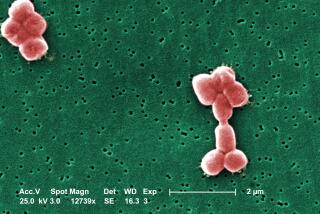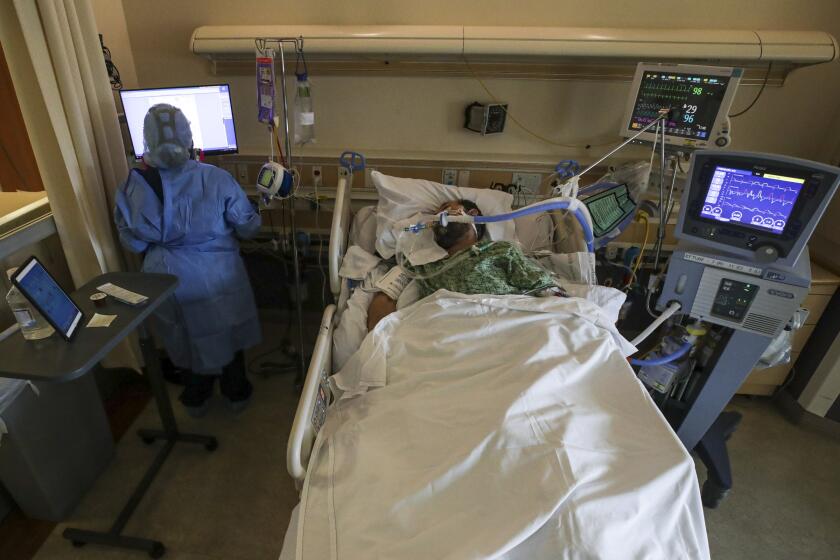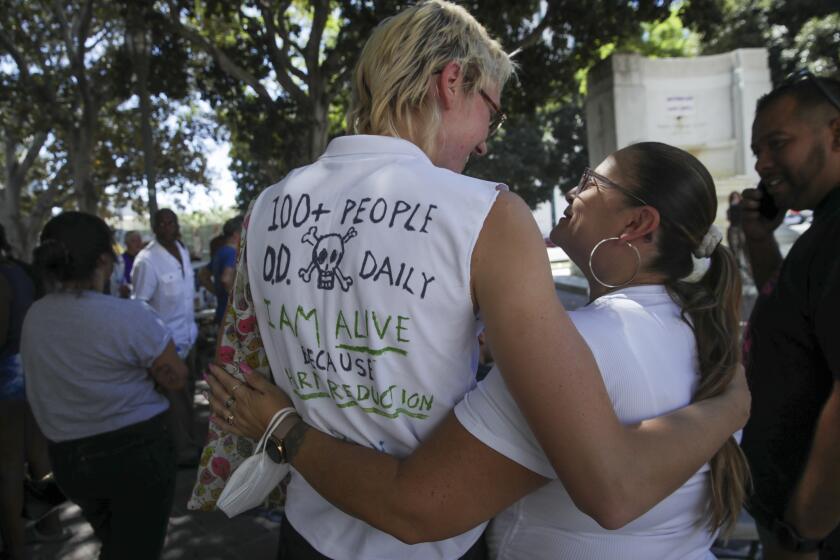Scientists Hunt Genetic Print of Anthrax Spores
Scientists seeking the genetic origins of the anthrax unleashed in recent attacks are exploring a scientific shadowland familiar to only a handful of molecular biologists, veterinary medical specialists and military biotechnicians, where the state of the art is itself a state secret.
In laboratories from New Mexico to Maryland, government and university researchers for the last week have employed the remarkable power--and confronted the limitations--of forensic molecular biology as they seek to determine where the anthrax came from.
With techniques unheard of even a few years ago in public health circles, researchers are attempting to read the cryptic biochemical signature of anthrax spores, in the hope they can find a clue that could lead to the bioterrorists who mailed the microbes to unsuspecting victims.
The scientists also can test the powder that has been mixed with the anthrax spores to see if it has any characteristics of known anthrax weapon programs. By examining the particles, they also can try to determine the degree of sophistication of the operation that produced the spores.
Investigators believe that the same strain of anthrax was used in three attacks in New York, Washington and Florida. That suggests the spores came from the same source. So far they are reluctant to say how they reached that conclusion or what it may mean for linking the spores to suspects.
No one directly involved in the scientific effort will discuss this criminal investigation of a microbe in any but the broadest terms. The leading academic experts in the field will not even acknowledge officially that they are working on the investigation.
But expertise about anthrax is concentrated in only a few facilities in the United States, so it is not difficult to know the outline of the work being done and where it is taking place.
Initial Screening Is State-Level Work
Initial screening of the anthrax spores is the work of state public health experts in areas where the outbreaks were detected. They subject the bacteria to a variety of conventional antibody tests that can determine whether anthrax is involved in an attack.
“This laboratory has been completely commandeered by anthrax in the past two weeks,” said Florida state public health biologist Paul Fiorella. “We put our emphasis on detection and identification of anthrax, but not on identifying strains.”
That work of identification requires sophisticated genetic analysis of the spores, which is believed to be underway at the Los Alamos National Laboratory in New Mexico and at the national Centers for Disease Control and Prevention in Atlanta. Several university laboratories also are deeply involved in trying to classify the anthrax strains more precisely.
At Northern Arizona University, Paul Keim, whose anthrax-typing program is widely considered the world’s best, declined to comment on whether his laboratory is involved in the current criminal investigation. But he acknowledged a major increase in research activity.
“As you can imagine, in the last few weeks we’ve accelerated our efforts,” said Keim. People in his lab who were busy working on plague, he said, are shifting their focus onto anthrax.
“Things we didn’t expect to get done six months or a year from now have gone right to the forefront--we’re literally developing the technology and the knowledge base as we go,” Keim said.
At the same time, bioweapons experts in Maryland and Utah no doubt are testing to see if the spores have any of the properties of microbes drafted for military duty.
On Friday, White House Homeland Security Director Thomas J. Ridge denied reports that anthrax in those incidents had been “weaponized” to make them more virulent or resistant to treatment.
All this detective work is handicapped by the character of the anthrax spores themselves and the incomplete catalog of known laboratory strains.
Anthrax occurs naturally around the world, and disease-causing strains differ. Some infect more readily than others; some carry a stronger load of toxin.
But the variations are subtle, making efforts to distinguish among them extremely difficult. In fact, strains of anthrax collected from even distantly separated locations are strikingly alike. “They are amazingly similar--it’s really surprising how few real, genetic differences there are in hundreds of isolates,” said anthrax researcher Theresa Koehler, associate professor of microbiology at the University of Texas, Houston.
No one knows why that is: perhaps B. anthracis evolved fairly recently and hasn’t had time to change much. Or maybe it’s because the microbe, as part of its life cycle, spends years as a dormant spore waiting to encounter a new animal to infect--and thus has fewer opportunities to change.
Finding Genetic Fingerprints
But differences do exist. A handful of anthrax scientists--most notably Keim and Paul Jackson at Los Alamos National Laboratory--have found nearly 1,000 places in the anthrax genome where the microbes vary from one another.
Even before the recent attacks, researchers were trying to use these differences to create a genetic fingerprint of each strain.
For instance, by analyzing just eight of these regions, Keim and colleagues showed, in a paper published last year, that they could divide 426 collected specimens of B. anthracis into 89 distinct groups. Analysis of a larger number of sites further helps distinguish among different anthrax strains.
So far, more than 1,000 strains have been distinguished on the basis of DNA differences, said Jill Trewhella, bioscience division leader at Los Alamos. That number is growing all the time, as more and more anthrax samples are collected and typed.
Unfortunately, Keim cautioned, “DNA typing is not the answer to everything.”
Many strains of anthrax are widely dispersed around the world. So while DNA typing can rule out certain sources, investigators will need much more supportive evidence to zero in on just one.
When Keim’s group analyzed the anthrax used in 1993 in several abortive bioterrorism attacks by the Japanese cult Aum Shinrikyo, DNA typing allowed the scientists to eliminate many potential sources of spores.
The spores didn’t come--as some had suggested--from the cult’s ranch in Australia, nor from strains endemic to the United States, nor from many others on file in Keim’s collection.
Instead, the anthrax matched a strain used to make a live vaccine for animals. The cult members unwittingly had used an anthrax strain, called Sterne, that is not capable of causing the disease.
But because there are so many samples of Sterne around the world, it wasn’t possible to pinpoint just where the spores had been obtained.
“That illustrates the quandary,” Keim said. “We excluded a lot of things but we still had multiple possible sources.”
If the Aum attacks had happened now, however, Keim said his laboratory might have been able to identify the source more precisely. Keim’s lab in the last few years has identified some DNA regions that change their structure a million times more quickly than do others. Two samples of an identical bacterium, if separated for enough generations, will begin to accumulate changes and diverge from each other. Those divergences will show up first in the areas of DNA that change most rapidly.
Thus, even if the spores used in the recent spate of letter attacks turn out to be from a commonly used strain, it may still be possible to narrow their origins more precisely--if the bacterium has divided enough times since the split.
“I’m just hoping beyond hope that they find the anthrax is something that’s been typed before--that it gives them some place to start looking and help build a picture and go after whoever did it,” said Eric Croddy, senior research associate at the Monterey Institute of International Studies.
Otherwise, Croddy said, the challenge will be immense: “Anthrax infects everything from elephants in India to yaks in Nepal.”






